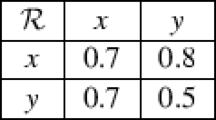Abstract
The concept of topologies are widely used in machine learning, and fuzzy automata are used as models of machine learning systems. An advantage of employing fuzzy automaton as a model of machine learning system is its simplicity in design and computation. Also, some standard topological concepts and ideas are used in fuzzy automata and IF-automata to obtain certain results therein. In view of above, it seems that IF-topologies and IF-automata may play vital role in the study of machine learning; the purpose of this work is to introduce and study IF-topologies and to use such studies in the theory of IF-automata.
Similar content being viewed by others
References
Acencio ML, Lemke N (2009) Towards the prediction of essential genes by integration of network topology, cellular localization and biological process information. BMC Bioinf 10:290
Albizuri FX, Danjou A, Grana M, Torrealdea J, Hernandez MC (1995) The high-order Boltzmann machine: learned distribution and topology. IEEE Trans Neural Netw 6:767–770
Atanassov K (1986) Intuitionistic fuzzy sets. Fuzzy Sets Syst 20: 87–96
De Baets B, Kerre EE (1994) Fuzzy relations and applications. Adv Electron. Electron Phys 89:255–324
Bandler W, Kohout L (1980) Fuzzy relational products as a tool for analysis and synthesis of the behaviour of complex natural and artificial systems. In: Theory and applications to policy analysis and information systems. Plenum, New York, pp 341–367
Bustince H, Burillo P (1996) Structures on intuitionistic fuzzy relations. Fuzzy Sets Syst 78:293–303
Carr DA, Lach-Hab M, Yang SJ, Vaisman II, Blaisten-Barojas E (2009) Machine learning approach for structure-based zeolite classification. Microporous Mesoporous Mater 117:339–349
Chen TY, Wang HP, Wang JC (2012) Fuzzy automata based on Atanassov fuzzy sets and applications on consumers, advertising involvement. Afr J Bus Manag 6:865–880
Chen TY, Chou CC (2009) Fuzzy automata with Atanassov’s intuitionstic fuzzy sets and their applications to product involvement. J Chin Inst Ind Eng 26:245–254
Choudhury MA, Zaman SI (2006) Learning sets and topologies. Kybernetes 35:1567–1578
Cock MD, Cornelis C, Kerre EE (2005) Intuitionistic fuzzy relational images. Stud Comput Intell 2:129–145
Coker D (1997) An introduction to Intuitionistic fuzzy topological spaces. Fuzzy Sets Syst 88:81–89
Cornelis C, Deschrijver G, De Cock M, Kerre EE (2002) Intuitionistic fuzzy relational calculus: an overview. In: Proceedings of 1st International IEEE Symposium. Intelligent Systems: Methodology, Models. Applications Emerging Technologies, vol 1, pp 340–345
Das P (1999) A fuzzy topology associated with a fuzzy finite state machine. Fuzzy Sets Syst 105:469–479
Deschrijver G, Kerre EE (2003) On the composition of intuitionistic fuzzy relation. Fuzzy Sets Syst 136:333–361
Deschrijver G, Cornelis C, Kerre EE (2004) On the representation of intuitionistic fuzzy t-norms and t-conorm. IEEE Trans Fuzzy Syst 12:45–61
Deschrijver G, Kerre EE (2005) On the cuts of intuitionistic fuzzy compositions. Kuwait J Sci Eng 32:17–38
Dubois D, Gottwald S, Hajek P, Kacprzyk J, Prade H (2005) Terminological difficulties in fuzzy set theory the case of intuitionistic fuzzy sets. Fuzzy Sets Syst 156:485–491
Grzegorzewski P, Mrówka E (2002) Soft querying via intuitionistic fuzzy sets. In: Proceedings of 9th International Conference Information Processing Management Uncertainty Knowledge-Based Systems, pp 1845–1849
Ignjatović J, Ćiric M, Simović V (2012) Fuzzy relation equations and subsystems of fuzzy transition systems. Knowl Based Syst. doi:10.1016/j.knosys
Jun YB (2005) Intuitionistic fuzzy finite state machines. J Appl Math Comput 17:109–120
Jun YB (2006) Intuitionistic fuzzy finite switchboard state machines. J Appl Math Comput 20:315–325
Jun YB (2007) Quotient structures of intuitionistic fuzzy finite state machines. Inf Sci 177:4977–4986
Kortelainen J (1999) On the evaluation of compatibility with gradual rules in information systems: a topological approach. Control Cybern 28:121–131
Kortelainen J (2001) Applying modifiers to knowledge acquisition. Inf Sci 134:39–51
Mordeson JN, Malik DS (2002) Fuzzy automata and languages: theory and applications, Chapman and Hall, Boca Raton
Qiu D (2004) Characterizations of fuzzy finite automata. Fuzzy Sets Syst 141:391–414
Qiu D (2004) Automata theory based on quantum logic: some characterizations. Inf Comput 190:179–195
Shukla W, Srivastava AK (1976) A topology for automata: a note. Inf Control 32:163–168
Srivastava AK, Shukla W (1986) A topology for automata II. Int J Math Math Sci 9:425–428
Srivastava AK, Tiwari SP (2002) A topology for fuzzy automata. Lecture Notes in Artificial Intelligence. In: Proceedings of 2002 AFSS International Conference on Fuzzy Systems, vol 2275. Springer, Berlin, pp 485–490
Srivastava AK, Tiwari SP (2003) On relationships among fuzzy approximation operators, fuzzy topology, and fuzzy automata. Fuzzy Sets Syst 138:197–204
Srivastava AK, Tiwari SP (2010) IF-topologies and IF-automata. Soft Comput 14:571–578
Tiwari SP, Singh AK (2013) Fuzzy preorder, fuzzy topology and fuzzy transition system. In: Proceedings of ICLA 2013. Lecture Notes in Computer Science, vol 7750. Springer, Berlin, pp 210–219
Tiwari SP, Singh AK (2013) On bijective correspondence between IF-preorders and saturated IF-topologies. Int J Mach Learn Cybern. doi:10.1007/s13042-013-0157-5.36.
Wee WG (1969) A formulation of fuzzy automata and its application as a model of learning systems. IEEE Trans Syst Sci Cybern 5:215–223
Wu WZ, Zhou L (2011) On intuitionistic fuzzy topologies based on intuitionistic fuzzy reflexive and transitive relations. Soft Comput 15:1183–1194
Zhou L (2010) Intuitionistic fuzzy residuated logic and Galois connection. In: Proceedings of PACCS, IEEE, pp 249–252
Acknowledgments
The authors are grateful to the referees for their valuable observations and suggestions for improving the paper. The author acknowledge with thanks the support received through a research grant, provided by the Council of Scientific and Industrial Research, New Delhi, under which this work has been carried out.
Author information
Authors and Affiliations
Corresponding author
Rights and permissions
About this article
Cite this article
Tiwari, S.P., Singh, A.K. IF-preorder, IF-topology and IF-automata. Int. J. Mach. Learn. & Cyber. 6, 205–211 (2015). https://doi.org/10.1007/s13042-013-0191-3
Received:
Accepted:
Published:
Issue Date:
DOI: https://doi.org/10.1007/s13042-013-0191-3




